Boost AOV using product add-ons effectively
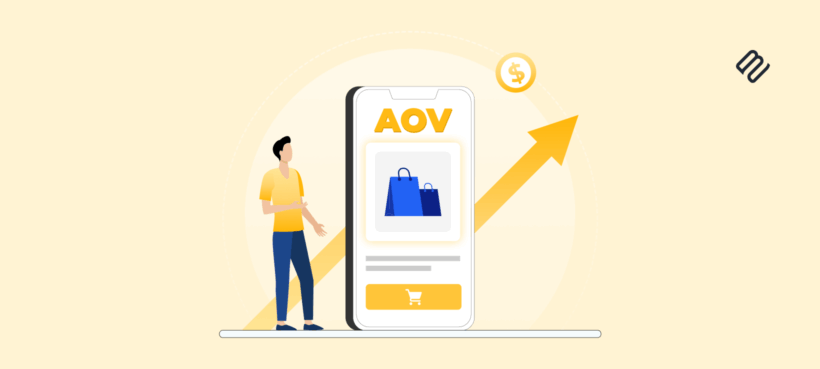
You're watching your store's average order value hover frustratingly around the same number month after month, despite steady traffic growth. I've been there - running ads, bringing in visitors, but seeing that AOV stubbornly refuse to budge beyond $47 or $52 or whatever your current ceiling seems to be.
There are lots of theories on how to improve average order value (AOV) in WooCommerce, but most of them don't work. The one method I'm aware of which makes a huge difference is upselling product add-ons.
This works when other tactics fail because selling add-ons enhances what customers already want to buy. Instead of pushing them toward different products (which creates decision friction), add-ons improve the exact item they've already chosen. When someone's ready to buy that $47 ring, offering $25 engraving doesn't feel like an upsell - it feels like completing their purchase properly.
This guide shows you exactly which product add-on strategies drive real AOV increases and how to implement them seamlessly in WooCommerce. You'll discover the psychology behind why certain add-ons convert at 40% while others barely hit 5%, plus the technical setup that makes the whole system run smoothly.
Why product add-ons work when other tactics fail
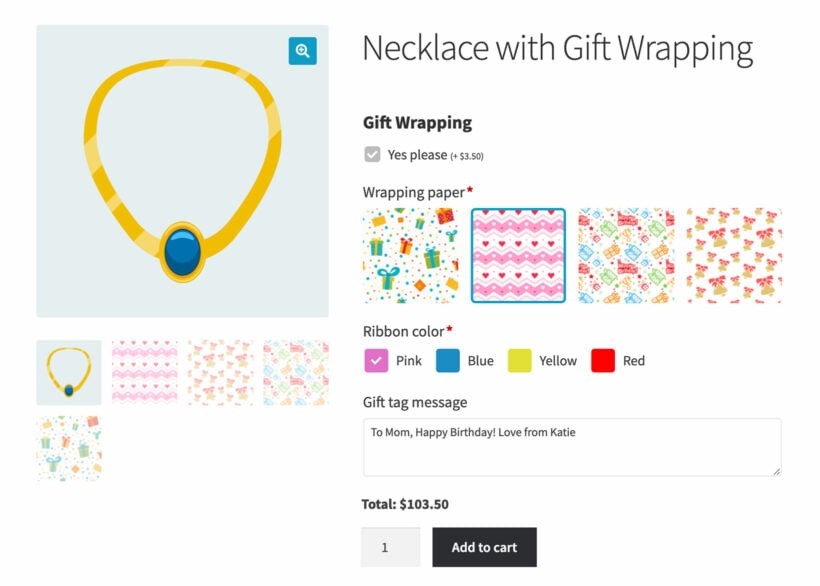
Product add-ons are modifications or enhancements to the main product itself. Think warranties, customization options, material upgrades, or services that enhance the primary purchase. They're fundamentally different from cross-sells because customers don't need to evaluate an entirely new product.
Product add-ons succeed where other AOV tactics fail for three key reasons:
- First, customers have already committed to the main product, so add-ons feel like logical improvements rather than separate purchase decisions. The mental work of deciding "should I buy this?" is already complete. Now they're just optimizing their choice.
- Second, higher AOV improves profit margins without increasing your marketing costs or inventory complexity. Every dollar added through product options is pure margin improvement since you've already paid to acquire that customer.
- Third, add-ons maximize value from traffic that's already interested in your specific products. Instead of hoping that visitors browse more items, you're capturing additional revenue from the exact product that brought them to your site.
This psychological advantage runs deeper than convenience. Add-ons succeed when they solve hesitations about the main purchase or enhance its value in meaningful ways.
For example - when a customer wants that $47 ring for their partner's birthday, offering engraving doesn't just add revenue - it solves their gift-giving anxiety and provides permission to complete the purchase they already want to make.
I've found that the best add-ons address unspoken concerns. Some examples:
- Protection plans work because they eliminate worry about damage.
- Gift wrap succeeds because it removes the hassle of presentation.
- Expedited processing converts because it solves urgency.
Understanding these psychological drivers is what separates 40% conversion add-ons from 5% conversion ones.
Product add-ons that really increase AOV
Not all product add-ons convert equally. After analyzing hundreds of WooCommerce stores, I've identified four categories that consistently drive AOV increases when matched to the right products and price points. The key is understanding which type fits your specific situation.
1. Customization add-ons
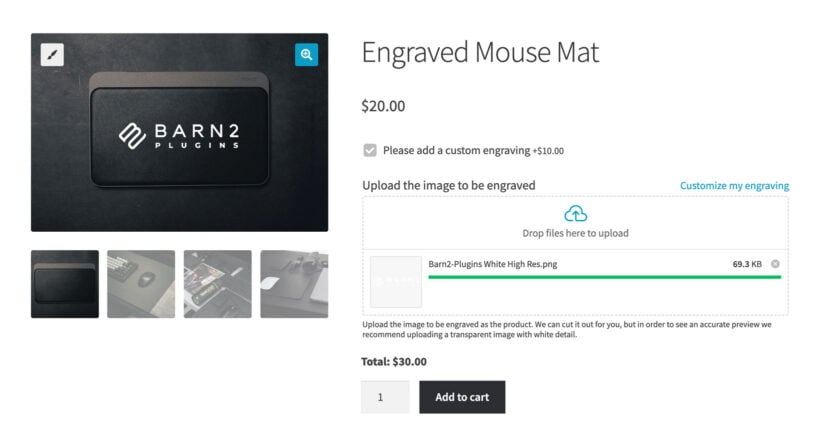
Customization add-ons make products uniquely personal. These include engraving, monogramming, custom colors, sizes, or personalized messages. They work exceptionally well for gifts, luxury items, and personal accessories where emotional value matters.
The sweet spot for customization pricing varies by base product value. As a general rule, consider this:
- For items under $50, keep customization between $3-8 (simple gift wrap or messages work best).
- Products from $50-150 can support personalizations at 15-25% of base price.
- Above $150, customers can set up premium customization with multiple options at 30-40% markup.
2. Material or quality upgrades

Material upgrades offer premium versions of the same product without requiring customers to navigate to different product pages. This might include premium leather instead of standard, expedited processing, bamboo instead of cotton, or professional gift packaging.
The conversion psychology here is fascinating. Customers who've decided to buy are often willing to upgrade when presented with the right option. Research shows that upselling can lead to revenue increases of 10-30% on average, but customers won't browse to find premium versions - the upgrade must appear at the moment of decision.
Some general guides:
- For products under $50, basic upgrades like gift packaging ($5-8) or expedited processing ($5-10) work best. Don't try to push major material changes on budget items.
- Between $50-150, material upgrades priced at 20-30% of base product convert well. Think organic cotton upgrade on a $75 hoodie for $20 more.
- Above $150, you can offer substantial material differences with 50%+ price increases. Luxury watch bands, premium leather on bags, or professional-grade components on tools all convert when the upgrade is visibly superior.
The critical factor is immediate value recognition. Customers must understand why the premium option costs more within seconds. Use comparison images showing standard versus premium materials. Include specific benefits like "softer hand-feel" or "10-year durability" rather than vague "premium quality" claims.
For example, a furniture store might increase their AOV simply by offering fabric upgrades on sofas. Instead of creating separate products for each fabric option, they can present swatches as add-ons with clear pricing.
3. Protection add-ons
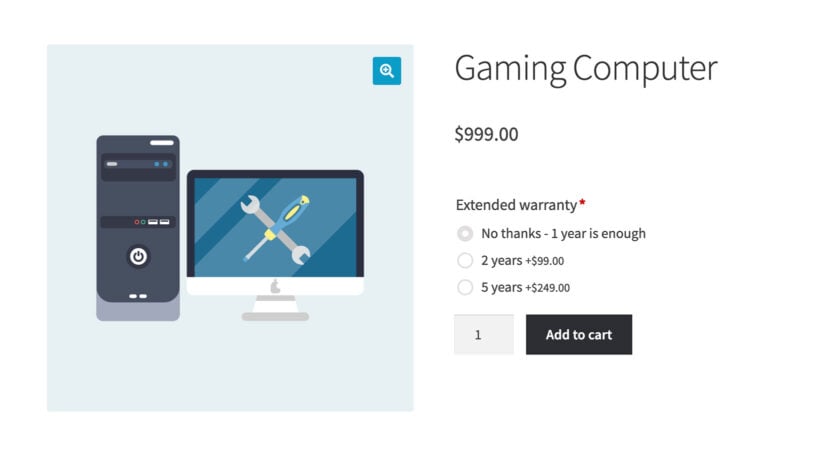
Protection add-ons include warranties, insurance, shipping protection, and damage coverage. They work by eliminating purchase anxiety, especially for electronics, jewelry, and items over approx. $75 where replacement cost creates genuine concern.
The pricing sweet spot for protection varies by product category but typically ranges from 10-20% of product value. Research shows that extended warranties in retail consumer electronics cost 20-30% of the product price, while industry analysis found warranties ranging from 10-25% depending on the product and retailer. Successful programs often price more competitively at 10-15% to maintain attachment rates.
- Skip protection entirely on items under $50 unless they're extremely fragile. The mental math doesn't work for customers.
- Between $50-150, offer protection at 8-12% of product value with clear coverage terms.
- Above $150, add premium protection options with white-glove service elements that justify 15-20% pricing.
The key to protection add-on success is timing and framing. Don't make customers think about what could go wrong with their exciting new purchase. Instead, frame protection as "maintaining your investment" or "worry-free ownership." Position it after they've made color and size selections but before the add to cart button.
Protection plans typically see varied take-up rates depending on product category and pricing. Industry data shows that customers buy extended warranties 20-40% of the time for consumer electronics.
4. Service add-ons
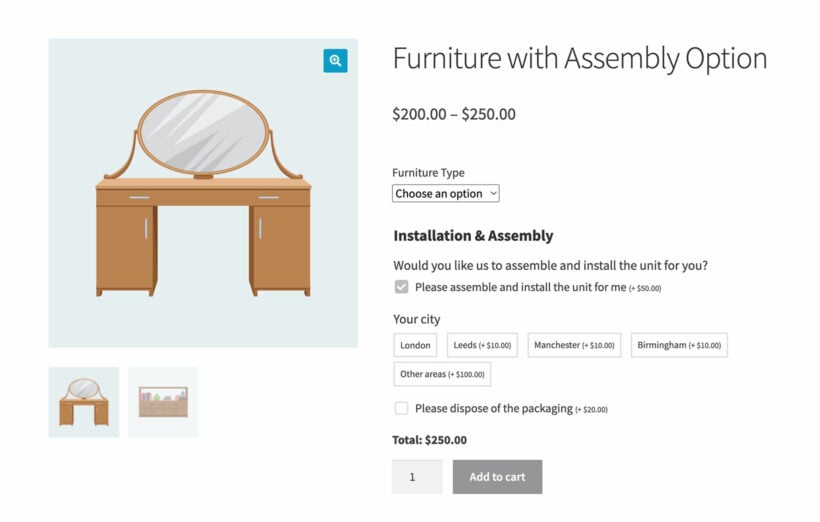
Service add-ons enhance product value through professional assistance: setup service, installation, training, priority support, or consultation. They work best for complex products, luxury purchases, and B2B sales where expertise adds genuine value.
Service add-ons require different pricing strategies by AOV tier:
- Under $50, skip services entirely - the economics don't work.
- From $50-150, limit services to digital delivery like priority support or setup guides (e.g. $10-25).
- Above $150, full white-glove services become viable and can command premium pricing.
The conversion trigger for services is complexity anxiety. For example, customers buying their first DSLR camera worry about learning to use it. Home gym equipment buyers fear incorrect setup. B2B software purchasers need implementation confidence. Address these fears directly with offering service add-ons.
Service add-ons work particularly well for complex products that benefit from professional setup. Home fitness equipment, furniture, and electronics all see strong conversion rates on assembly and installation services when priced appropriately relative to the base product value.
Streamlining product add-ons with WooCommerce Product Options
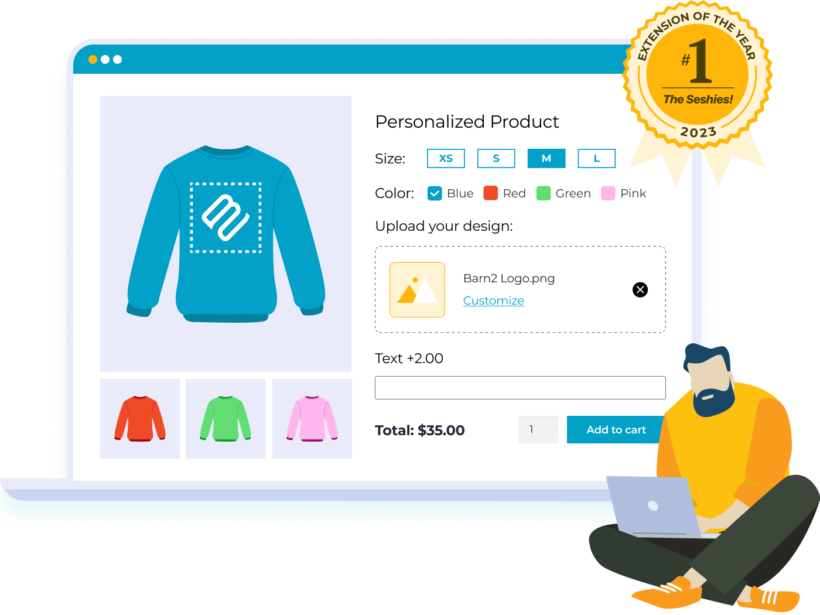
By now, you know what a difference product add-ons can make to AOV. So the next step is to add them to your store.
The WooCommerce Product Options plugin transforms basic product pages into sophisticated add-on systems without touching code. It perfectly handles complex add-on logic while keeping the customer experience smooth and intuitive.
Huge range of add-on styles
You can create product add-ons using dropdowns, checkboxes, text boxes, file uploads, and many other field types. Each option appears exactly where customers make purchase decisions - above the add to cart button where they can't miss it.
Show and hide add-ons with conditional logic
What sets WooCommerce Product Options apart is the conditional logic system. You can show warranty options only for electronics over $100, display premium materials only after base selection, or reveal bulk pricing when quantities increase. This prevents overwhelming customers with irrelevant choices.
For example, this necklace product provides gift wrap add-ons which are hidden until you tick a checkbox. This activates the conditional logic, keeping the page clean and tidy:
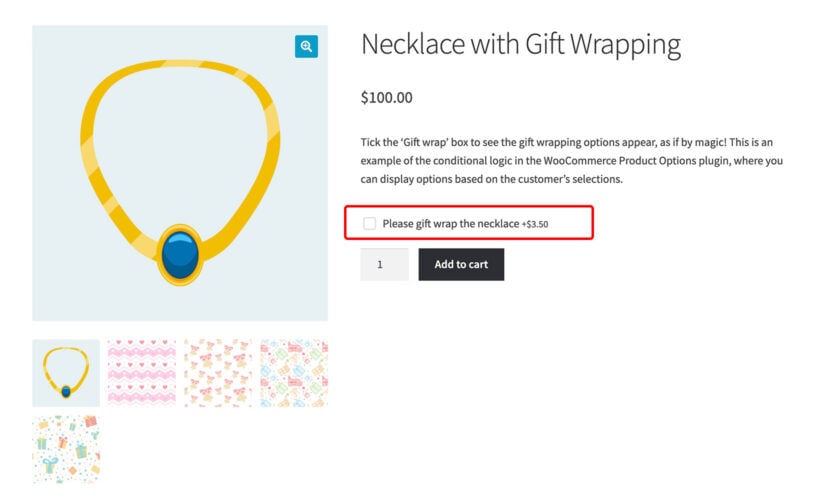
Boost AOV by charging for add-ons
You can add a range of price options to your WooCommerce product add-ons.
The pricing flexibility handles any business model. Set percentage-based markups that scale with product price, flat fees for simple add-ons, per-character charges for personalization, or complex pricing formulas for custom calculations. For example, a furniture store might use formulas to calculate custom sizing costs automatically.
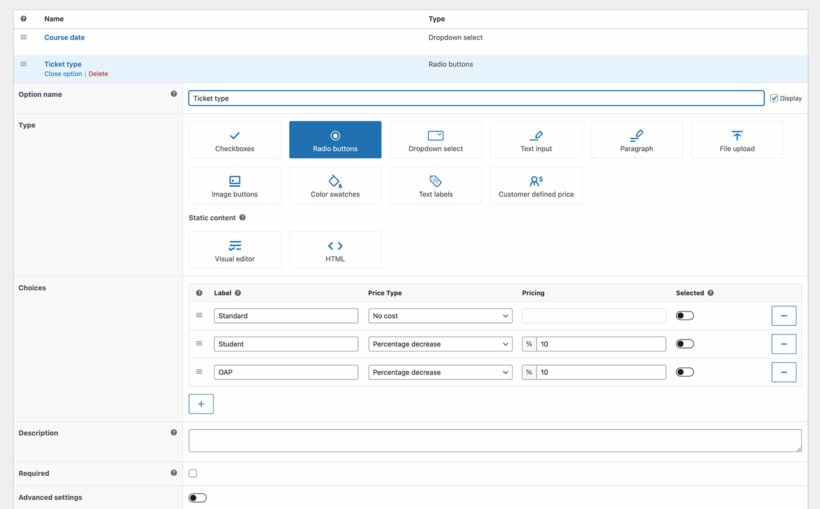
Here's a real example of setting up a customizable ring with escalating add-ons:
- First, create the base ring product.
- Then add a metal upgrade option group with silver, white gold, and platinum choices, each with percentage-based pricing.
- Next, add an engraving text field with per-character pricing ($2 per character, maximum 20 characters).
- Finally, create a gift box checkbox that appears only when engraving is selected.
The result? Customers see a logical flow of enhancement options. Select metal, add personal engraving if desired, then complete with gift presentation. Average order value on this ring jumped from $67 to $94 - a 40% increase from strategic add-on placement.
Fine-grained control
WooCommerce Product Options' bulk management capabilities save hours when scaling. You can apply option groups across entire categories or specified products. That way, you can update pricing globally with one click, and manage complex catalogs of add-ons without editing individual products.
The time savings alone justify the investment before considering revenue increases due to the increased AOV.
Pro tips: Optimizing product page add-ons
The way in which you present and implement your product add-ons will affect AOV and conversion rates more than any other factor. After analyzing heat maps and session recordings from dozens of stores, clear patterns emerge about what works and what kills conversions.
- PrioritizeStart with your highest-converting add-on positioned prominently near the add-to-cart button. Protection and expedited shipping typically convert best, so lead with these. Secondary add-ons should follow in logical order - customization before accessories, accessories before protection. This creates a natural decision flow.
- IOptimize for mobile usersMobile optimization is non-negotiable. In the first quarter of 2025, 68% of online shopping orders are done over a smartphone. Complex option layouts that work on desktop become conversion killers on mobile. Test every add-on combination on actual mobile devices, not just browser emulators.
- Use pricing psychology to drive purchase decisionsDisplay add-on prices as flat fees ($25 engraving) rather than percentages (15% customization fee) whenever possible. That's because percentages make customers do complex calculations in their head, which creates friction. Pre-select popular seasonal add-ons like gift wrap during holidays, but make deselection obvious with a clear checkbox.
- Hide lower value add-onsShow basic add-ons immediately, then use conditional logic to reveal premium options as customers engage. Someone selecting a basic t-shirt doesn't need to see premium packaging options until they've chosen the size and color. This reduces cognitive load while maintaining upsell opportunities.
Don't overwhelm the customer!
Here's one thing I've learned about customer psychology: you need to limit options to prevent paralysis. More than 3-4 customization choices creates decision fatigue and actually reduces conversions. Focus on the most meaningful personalizations for your product type.
For jewelry stores, engraving converts at 35-45% when positioned as "make it truly theirs." Fashion retailers see 20-30% uptake on monogramming for bags and accessories. Even commodity products benefit - I've seen basic cutting boards increase AOV by $15 just by offering custom text engraving.
The implementation trick is making customization feel essential rather than optional. Don't bury it below the fold. Place customization options directly next to size or color selections where customers are already making choices. Use language like "personalize your gift" rather than "add customization" to frame it as completing the purchase properly.
Always be optimizing 📈
The most successful stores treat add-on optimization as an ongoing process, not a one-time setup. To do this, you should track which add-ons convert, at what price points, and for which products. Also test positioning, language, and bundling strategies.
Small improvements compound into significant AOV gains.
Implement your product add-on strategy today
Product add-ons increase average order values because they enhance what customers already want rather than pushing them toward different products. Protection plans, customization options, material upgrades, and service add-ons each serve specific customer needs when matched to appropriate product types and price points.
The technical implementation doesn't need to be complicated. WooCommerce Product Options provides the complete toolkit: flexible option types, conditional logic, dynamic pricing, bulk management, and professional presentation that converts browsers into buyers.
Start small with your best-selling product. Add one protection option or customization field. Measure the impact on AOV over two weeks. Then expand systematically across your catalog, using data to guide which add-ons to implement where. Done properly, you should see meaningful AOV improvements within 30 days of implementing your first strategic add-ons.
Ready to stop leaving money on the table? Get WooCommerce Product Options today and transform flat AOV into sustainable revenue growth. Remember - your customers want to spend more - you just need to give them the right options at the right moment.